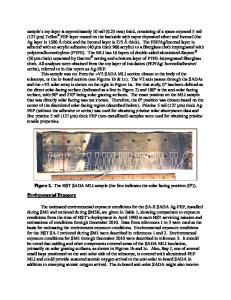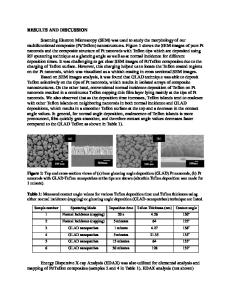Hydrophobicity of Teflon Coated Well-Ordered Silver Nanorod Arrays
- PDF / 1,538,489 Bytes
- 5 Pages / 612 x 792 pts (letter) Page_size
- 27 Downloads / 301 Views
Hydrophobicity of Teflon Coated Well-Ordered Silver Nanorod Arrays Arif S. Alagoz1, Wisam J. Khudhayer2, and Tansel Karabacak1 1 Department of Applied Science, University of Arkansas at Little Rock, Little Rock, AR 72204, U.S.A. 2 Department of Systems Engineering, University of Arkansas at Little Rock, Little Rock, AR 72204, U.S.A. ABSTRACT From wings of flies to plant leafs, hydrophobic surfaces are well-common in nature. Many of these surfaces have micro and nano hierarchical structures coated with low surface energy layer. In this work, we mimicked similar structure by fabricating Teflon coated periodic and well-ordered silver nanorod arrays and investigated the effect of nanorod separation on water contact angle (WCA). The silver nanorod arrays were deposited on patterned and flat silicon substrates using glancing angle deposition (GLAD) technique. Then a thin layer of Teflon was deposited on the silver nanorods by small angle deposition (SAD) technique. A systematic increase in water contact angle was observed with increasing nanorod separation which is attributed to the decreased area fraction of solid-liquid interface. INTRODUCTION From wings of flies to plant leafs, hydrophobic surfaces can be observed at many animals and plants in nature. The well-known example is the lotus flower which grows in swamps and shallow waters but stays totally clean. The secret of lotus and many others is their micro and/or nano scale textured surfaces coated with a thin layer of low surface energy material1. The increase in hydrophobicity with increasing surface roughness is described by Wenzel and Cassie based on full and partial wetting of the surface, respectively2. Inspiring from the design of lotus flower; many researchers investigated the effect of feature shape and periodicity of the underlying substrates on the hydrophobic property3. These studies addressed the potential application of superhydrophobic surfaces in various industry products including self-cleaning surfaces4, anti-icing coatings5, water-repellent textiles6 and microfluidic devices7. In this study, we prepared well-ordered periodic and nonperiodic silver nanorod arrays using glancing angle deposition on patterned and flat silicon substrates, respectively, and coated with low surface energy Teflon thin film by small angle deposition (SAD) technique. The patterned substrates were prepared utilizing nanosphere lithography (NSL) technique. The NSL involves three principles steps. First, mono- or double- layers of nanospheres are formed on a substrate via a self-assembly process. Second, the voids between the spheres act as a shadow mask during thin film deposition. Finally, the spheres are removed to leave behind nanostructured patterns, such as nanoislands, on the substrate. NSL offers precise control over surface pattern at the nanometer scale simply by using spheres of different diameters. Since nanorods are directly grown on these nanoislands, changing the size of spheres results in a systematic increase in water contact angle as the nanorods separation i
Data Loading...










